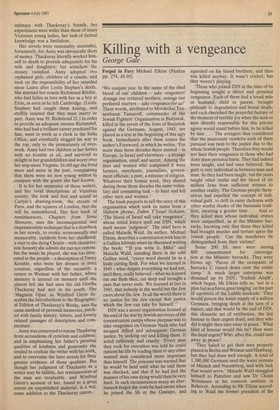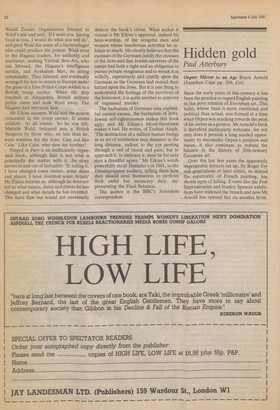Killing with a vengeance
George Gale
Forged in Fury Michael Elkins (Piatkus pp. 274, £6.95) 'We conjure you: In the name of the shed blood of our children — take vengeance! Avenge our tortured mothers, avenge our profaned martyrs — take vengeance for us!' These words, attributed to Mordechai Tennenbaum Tamaroff, commander of the Jewish Fighters' Organisation in Bialystok, killed in the revolt of the Jews of Bialystok against the Germans, August, 1943, are placed as a text at the beginning of this ugly book. Immediately after them comes the author's Foreword, in which he writes, 'For more than three decades there existed — in Europe, in Israel and elsewhere — a strange organisation, small and secret. Among the men and women who composed it were farmers, merchants, journalists, government officials; a poet, a minister of religion. Whatever their formal work, they shared during those three decades the same voluntary and consuming task — to hunt and kill other men and women.'
The book purports to tell the story of this organisation which took its name from a Hebrew phrase, Dahm Y'Israel Nokeam, 'The blood of Israel will take vengeance', whose initial letters spell out DIN, which itself means 'judgment'. The chief hero is called Malachi Wald. Its author, Michael Elkins, describes a conversation with him in a Galilee kibbutz when he discussed writing the book: 'If you write it, Mike" said Malachi Wald, standing there in the cold Galilee wind, "every word should be as a knife cutting flesh. For what we learned in 1945 — what despite everything we had not, until then, really believed—what we learned cut our flesh then, cut deep and brought a pain that never ends. We learned at last in 1945, that nobody in the world but the Jew cares about the Jew. In all the world there is no justice for the Jew except that justice which the Jew can take for himself."
DIN was a secret organisation formed at the end of the war by Jewish survivors of the concentration camps whose purpose was to take vengeance on German Nazis who had escaped Allied and subsequent German justice, by seeking out and killing them. It acted ruthlessly and cruelly: 'Every man they took for execution was told he could ransom his life by leading them to any other wanted man considered more important than himself. The prisoner was warned that he would be held until what he told them was checked, and that if he had lied the manner of his own dying would then be very hard. In such circumstances many an iibermensch forgot the vows he had sworn when he joined the SS or the Gestapo, and squealed on his blood brothers, and then was killed anyway. It wasn't cricket, but they weren't playing.
'Those who joined DIN at the time of its beginning sought a direct and personal vengeance. Each of them had a loved wife or husband, child or parent, brought pitilessly to degradation and brutal death; and each cherished the prayerful fantasy of the moment of terrible joy when the man or men directly responsible for this private agony would stand before him, to be killed by him . . . The avengers thus considered that the passionate vendetta each of them pursued was twin to the justice due to the whole Jewish people. Therefore they would not limit their vengeance to those who had done them personal harm. They had indeed been taught, and had once believed, that guilt is only individual as between man and man. So they had been taught, but the years taught other truths and the blood of six million Jews bore sufficient witness to another reality. The German people themselves had expelled the concept of individual guilt, to drift in outer darkness with other wistful shades of the humanist tradition, awaiting a gentler time . . . And so they killed men whose individual crimes were unspecified, as at the Miinster barracks, knowing only that those they killed had brought murder and torture upon the Jewish people.' Can the murderers be distinguished from their victims?
Some 200 SS men were among 800 concentrated for interrogation at the Munster barracks. They were blown up: 'Pieces of the occupants of barracks C rained down over the entire camp.' A much larger enterprise was dreamed up by DIN, `Tochnit Aleph', which began, Mr Elkins tells us, 'not as a plan but as a fierce great longing' on the part of survivors of the Lublin stockade: 'They would poison the water supply of a million Germans, bringing death at the turn of a faucet; and that would be the end of DIN, this climactic act of retribution, the last honour to their urgent dead; and they who did it might then turn away in peace.' What kind of honour would this be? How were the dead urgent? Who, after this, could turn away in peace?
'They failed to get their men properly placed in Berlin and Weimar and Hamburg, but they had done well enough. A total of 1,380,000 Germans used the water systems of Munich and Nuremberg, and with luck that would serve.' Malachi Wald smuggled himself to Palestine and saw Dr Chaim Weizmann at his research institute in Rehovot. According to Mr Elkins according to Wald the former president of the World Zionist Organisation listened to Wald's tale and said, 'If I were you, having lived as you, I would do what you will do', and gave Wald the name of a bacteriologist who could produce the poison. Wald went to the Hagana leaders, for authority and assistance, seeking Yitzhak Ben-Avi, who ran Mossad, the Hagana's intelligence service, and Avshalom Mor, its acting commander. They listened, and eventually arranged for him to return to Europe under the guise of a Free Polish Corps soldier in a British troop carrier. When the ship touched at Alexandria British military police came and took Wald away. The Hagana had betrayed him.
Mr Elkins assumes Wald had the poison concealed in the troop carrier. It seems unlikely. At all events: 'So he was left. Malachi Wald, betrayed into a British dungeon by those who, no less than he, were warriors for the Jews. Cast out like Cain.' Like Cain, who slew his brother?
Forged in Fury is an inefficiently organised book, although that is not what is principally the matter with it. Its story moves in and out of factuality: 'In telling it, I have changed some names, some dates and places; I have invented some details' Mr Elkins informs us, although he does not tell us what names, dates and places he has changed and what details he has invented. This must flaw but would not necessarily destroy the book's virtue. What makes it vicious is Mr Elkins's approval, indeed his hero-worship, of the vengeful men and women whose murderous activities he relishes so much. He clearly believes that the excesses of the Germans justify the excesses of the Jews and that Jewish survivors of the camps had both a right and an obligation to pursue private vengeance and to wreak it as wilfully, capriciously and cruelly upon the Germans as the Germans had vented their hatred upon the Jews. But it is one thing to understand the feelings of the survivors of the holocaust; it is quite another to approve of organised murder.
The barbarism of Germans may explain, but cannot excuse, the barbarism of Jews. Jewish self-righteousness makes this book ugly; and Mr Elkins's blood-thirstiness makes it bad. He writes, of Tochnit Aleph, 'The destruction of a million human beings as an act of retribution may shimmer in the long distance, radiant to the eye peering through a veil of blood and pain; but to approach it, to embrace it, must be for sane men a dreadful agony.' Mr Elkins's words powerfully recall Himmler's in 1941, to the Einsatzgruppen soldiers, telling them how they should steel themselves to perform their awful but necessary duty, implementing the Final Solution.
The author is the BBC's Jerusalem correspondent.







































 Previous page
Previous page